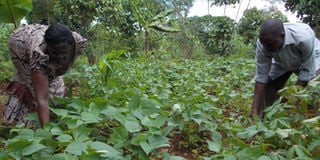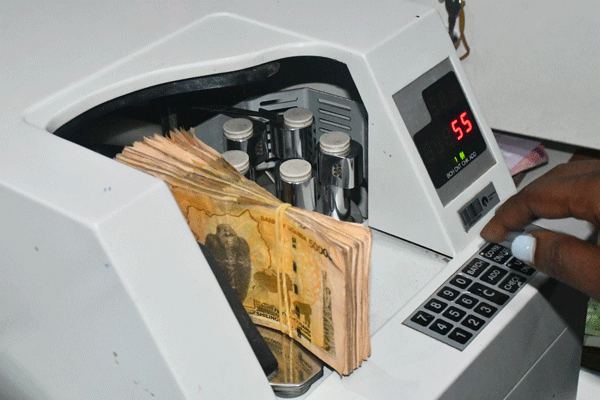Prime
Good bean production practices to enhance profits

Bean farmers attend to their garden. Photo / Michael J Ssali
What you need to know:
- They, therefore, needs to adopt cost-effective measures to ensure that their crops and animals grow well and that the yields are high and handled well to avoid losses.
It is assumed that every farmer wants to achieve high yields from every agricultural activity that they undertake.
They, therefore, needs to adopt cost-effective measures to ensure that their crops and animals grow well and that the yields are high and handled well to avoid losses.
Agronomy of beans
Agriculturalists suggest that beans are grown on a fertile and well-drained soil with sufficient aeration. It is also recommend that the farmer makes good seed selection to achieve the best results.
“Good quality seed, which is well developed, mature and uniform, should be planted for good germination and seeding vigour,” reads in part a booklet from National Agricultural Research Organisation (Naro) titled: “Introduction to basics on beans production.”
Preparing the seedbed
A fine seedbed must be prepared to ensure uniform and proper growth from germination which can reduce the number of times of weeding in a season.
If the seedbed is ready in good time and the beans are planted as the rains begin, the crop has more chances of germinating and emerging out of the ground before the weeds do. It is advised that where there are notorious weeds such as couch grass, herbicides are used to destroy them and that this should take place some three weeks before the beans are planted.
“Beans require fairly deep fertile soils and should not be planted on rocky or very steep slopes,” the book further reads.
Apply fertilisers
Mr Augustine Kasumba, a retired Sub-county agricultural officer, in Lwengo District, recommends that all previous crop residues should be removed from the plot where beans are to be planted for the sake of ensuring that no pests and diseases are passed on to the beans that are to be grown there.
“Where the soil is not so fertile the farmer may use organic fertiliser such as livestock droppings by spreading it evenly all over the garden and then ploughing,” Kasumba says.
“The fertiliser should be well mixed with the soil for the beans to grow with uniform vigour,” he further says. “It is also good to apply manufactured fertilisers as long as user directions are followed.”
He said however that as much as possible farmers should apply inorganic manure following soil test by a trained agriculturist since a wide range of soils across the country have different fertility issues.
“Otherwise, inorganic fertilisers such as Urea, NPK, CAN, or DAP and liquid fertilisers such as Super Grow can be used depending on what is lacking from the soil.”
Straight lines
He emphasises the importance of planting beans in straight lines. His reason for recommending planting crops such as beans in straight rows is that each bean plant needs enough space in which to grow and the farmer also needs sufficient space in which to walk doing farm inspection or applying fertilisers or spraying fungicides.
Beans should be planted at the onset of rains with the farmer being conscious that sometimes when the rain is too much the pods could rot. Yet if the rain is insufficient or not consistent the beans can get stunted. Some farmers usually delay planting by up to two weeks after the rains have started just trying to assess the weather conditions.
Weed early
Planted beans must be free of weeds and the farmer must regularly inspect the garden removing weeds and checking for any possible pest or disease attacks.
The farmer must also be on the lookout for farmed animals such as goats and cattle which can feed on the bean leaves and destroy the crop.
In some cultures it is okay to harvest some bean leaves and eat them as vegetables.
Harvesting
Depending on the farmer’s preference, beans should be harvested when they are mature like when they begin to yellow for cooking, eating, and selling when they are fresh or when they are completely dry for storing, home consumption, and marketing.
Mr Charles Katabalwa, a trained agriculturist and chief executive officer of Community Enterprises Development Organisation (Cedo) which promotes bean production in the greater Masaka region, says beans harvested when they are totally dry must be very carefully handled to avoid pest infestation.
He says they must be threshed and dried on clean mats, cemented floors, or tarpaulin. “It is no longer really necessary to apply pesticides on harvested dry beans,” he told Seeds of Gold.
Storage
“Farmers can now buy special bags in which beans can be kept for months without any fear of pest attack.”
He says the two types of bags are Triple Bag and Pics Bag and said they are available in some farmers’ shops in Masaka City.
He advises bean farmers to buy the bags since they can be used for a number of seasons and for years.
Katabalwa also says that farmers who cannot easily afford the bags can put dried tobacco leaves in the beans since it repels pests and other insects.
He goes on to reveal that when beans are threshed and not winnowed and kept in a dry place inside a house they are not easily attacked by pests.
“It is the reason that some people in Eastern Uganda just hang up the beans without threshing them,” he says. “Once left in their dry pods they will remain intact until the farmer needs them.”
Marketing
Before presenting the beans for selling, it is important to ensure that they are really well sorted and not carrying any foreign matter such as stones and husks.
They should be dried under the sun for at least two hot days according to National Agricultural Research Organisation (Naro) guidelines.
As the farmer waits for the beans to dry under the sun care must be taken to prevent household livestock from walking over them since they can crash and break them or even contaminate them with their droppings.
Also broken or damaged beans and beans of strange colour or unpleasant appearance should be removed.
If the beans are kept in bags they should not be directly placed on the floor where they could pick moisture.
Rather, place them on planks or well laid wooden poles and about two or three feet from the walls of the building.
Seedbed
A fine seedbed must be prepared to ensure uniform and proper growth from germination which can reduce the number of times of weeding in a season.




